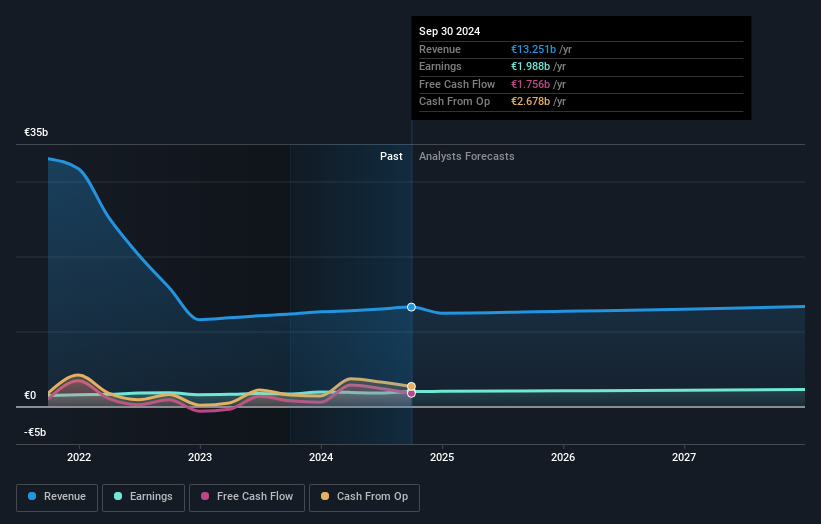Poste Italiane S.p.A.'s (BIT:PST) top owners are private companies with 35% stake, while 30% is held by state or government

Key Insights
- Poste Italiane's significant private companies ownership suggests that the key decisions are influenced by shareholders from the larger public
- 65% of the business is held by the top 2 shareholders
- Institutions own 10% of Poste Italiane
Every investor in Poste Italiane S.p.A. (BIT:PST) should be aware of the most powerful shareholder groups. And the group that holds the biggest piece of the pie are private companies with 35% ownership. In other words, the group stands to gain the most (or lose the most) from their investment into the company.
And state or government on the other hand have a 30% ownership in the company.
Let's delve deeper into each type of owner of Poste Italiane, beginning with the chart below.
See our latest analysis for Poste Italiane

What Does The Institutional Ownership Tell Us About Poste Italiane?
Many institutions measure their performance against an index that approximates the local market. So they usually pay more attention to companies that are included in major indices.
Poste Italiane already has institutions on the share registry. Indeed, they own a respectable stake in the company. This implies the analysts working for those institutions have looked at the stock and they like it. But just like anyone else, they could be wrong. It is not uncommon to see a big share price drop if two large institutional investors try to sell out of a stock at the same time. So it is worth checking the past earnings trajectory of Poste Italiane, (below). Of course, keep in mind that there are other factors to consider, too.

Poste Italiane is not owned by hedge funds. Looking at our data, we can see that the largest shareholder is Cassa Depositi e Prestiti S.p.A. with 35% of shares outstanding. With 30% and 2.0% of the shares outstanding respectively, Ministero dell'Economia e delle Finanze and BlackRock, Inc. are the second and third largest shareholders.
A more detailed study of the shareholder registry showed us that 2 of the top shareholders have a considerable amount of ownership in the company, via their 65% stake.
While studying institutional ownership for a company can add value to your research, it is also a good practice to research analyst recommendations to get a deeper understand of a stock's expected performance. Quite a few analysts cover the stock, so you could look into forecast growth quite easily.
Insider Ownership Of Poste Italiane
While the precise definition of an insider can be subjective, almost everyone considers board members to be insiders. Management ultimately answers to the board. However, it is not uncommon for managers to be executive board members, especially if they are a founder or the CEO.
I generally consider insider ownership to be a good thing. However, on some occasions it makes it more difficult for other shareholders to hold the board accountable for decisions.
Our data cannot confirm that board members are holding shares personally. Not all jurisdictions have the same rules around disclosing insider ownership, and it is possible we have missed something, here. So you can click here learn more about the CEO.
General Public Ownership
The general public-- including retail investors -- own 25% stake in the company, and hence can't easily be ignored. While this size of ownership may not be enough to sway a policy decision in their favour, they can still make a collective impact on company policies.
Private Company Ownership
Our data indicates that Private Companies hold 35%, of the company's shares. It might be worth looking deeper into this. If related parties, such as insiders, have an interest in one of these private companies, that should be disclosed in the annual report. Private companies may also have a strategic interest in the company.
Next Steps:
I find it very interesting to look at who exactly owns a company. But to truly gain insight, we need to consider other information, too. Consider for instance, the ever-present spectre of investment risk. We've identified 1 warning sign with Poste Italiane , and understanding them should be part of your investment process.
If you are like me, you may want to think about whether this company will grow or shrink. Luckily, you can check this free report showing analyst forecasts for its future.
NB: Figures in this article are calculated using data from the last twelve months, which refer to the 12-month period ending on the last date of the month the financial statement is dated. This may not be consistent with full year annual report figures.
New: Manage All Your Stock Portfolios in One Place
We've created the ultimate portfolio companion for stock investors, and it's free.
• Connect an unlimited number of Portfolios and see your total in one currency
• Be alerted to new Warning Signs or Risks via email or mobile
• Track the Fair Value of your stocks
Have feedback on this article? Concerned about the content? Get in touch with us directly. Alternatively, email editorial-team (at) simplywallst.com.
This article by Simply Wall St is general in nature. We provide commentary based on historical data and analyst forecasts only using an unbiased methodology and our articles are not intended to be financial advice. It does not constitute a recommendation to buy or sell any stock, and does not take account of your objectives, or your financial situation. We aim to bring you long-term focused analysis driven by fundamental data. Note that our analysis may not factor in the latest price-sensitive company announcements or qualitative material. Simply Wall St has no position in any stocks mentioned.
About BIT:PST
Poste Italiane
Provides postal, logistics, and financial and insurance products and services in Italy.
Solid track record average dividend payer.
Similar Companies
Market Insights
Community Narratives



